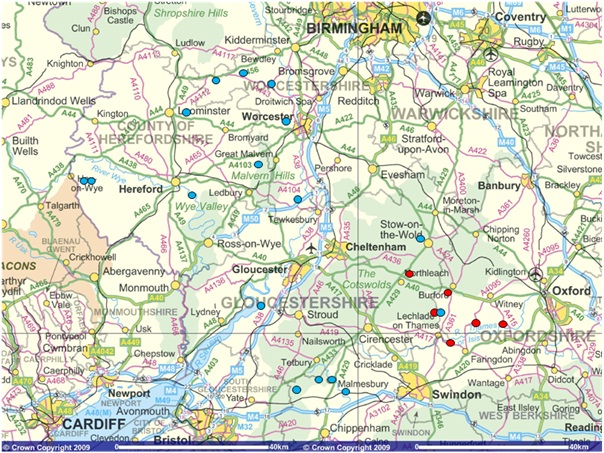| Who were the Poyntz's? |
Early family genealogy is always fraught with difficulty, but Burke's Peerage, recognised as about the most authoritative source, lists a family tree as in the illustation here. The Nicholas Poyntz shown as a holder of Sutton Poyntz in the medieval document called Testa de Nevill is listed in Burke's Peerage as Nicholas Fitz-Pons, and is known to have died in 1223. After him, 4 generations of Poyntz's are recorded as having held Sutton Poyntz.
Nicholas is believed to have descended from someone called Simon Fitz-Pons, the youngest of five sons of someone called Pons. We know that Pons existed, and lived around the time of the Norman Conquest, firstly because an early document belonging to Westminster Abbey shows that he gifted land at Wallingford to the Abbey, and secondly because the Domesday Book lists two significant land-holders, Drogo and Walter, as "sons of Pons". The map below shows the land-holdings of Drogo (as blue dots) and Walter (red dots). So Pons existed, and had at least two sons; as his sons were land-holders in 1086, we can infer reliably that Pons himself had died before that date.
|
Manors held in Domesday Book by Drogo (blue dots) and Walter (red dots), sons of Pons |
The existence of the younger sons of Pons is inferred rather than proved. Another brother shown in the accepted genealogy is Richard, who seems to have held land on the Welsh borders. He was the ancestor of the Clifford family, later Barons de Clifford and Earls of Cumberland. Richard's grand-daughter, Rosamund Clifford (Fair Rosamund) was mistress to King Henry II.
| And who was Pons? |
There is no documentation about who Pons was. The Clifford family have suggested that he was a Norman, and was the son of a Norman noblaman, William Comte de Hiemes. It is a reasonable guess that he was Norman rather than Anglo-Saxon, to justify the land-holdings of his sons soon after the Conquest. But we can be fairly certain that the Comte de Hiemes was not his father; a Norman monk called William de Jumieges wrote a book in 1070 in which he listed the three sons of the Comte, all known and none of them identifiable with Pons [see below].
A medieval document called the "Battle Abbey Roll" lists Pons as a member of the Norman army at Hastings, but this whole document dates from much later, and is of very dubious value [see below].
So sadly, we conclude that the background and history of Pons is lost forever.
See page 11 of Volume 2 of "The Gesta Normannorum Ducum of William de Jumieges, Orderic Vitalis and Robert of Torigni, Volumes 1 and 2" edited and translated by Elisabeth van Houts. The "Gesta Normannorum Ducum" was a contemporaneous record of the Dukes of Normandy, written by a monk called William de Jumieges in about 1060, and then extended in 1070 to include the Conquest. It was further extended later, to include events up to the reign of Henry I. A snippet view of Volume 2 is available on the internet, including the list of the sons of William Comte de Hiemes.
The "Battle Abbey Roll" was allegedly a list of the people who fought in the Norman army at Hastings, erected at Battle Abbey. The roll itself either never existed or has been lost; the earliest copies of the list of people date from the 16th Century, and are known to have a number of errors and inconsistencies. In fact, there are only 15 people (or perhaps 21) who can be shown confidently to have fought with Duke William at Hastings. Pons is not among them, but two people on the list have much later family relationships with the Poyntz's - Robert de Beaumont, whose younger brother may have been ancestor of the Newburgh's, and William de Malet, ancestor of Helewise Malet who married Hugh Poyntz, bringing him the Lordship of Curry Mallet in Somerset.

